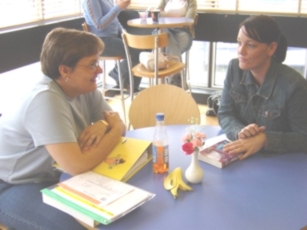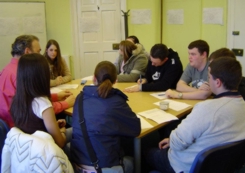
Data Collection
Data collection took place in three discrete phases: phase one (surveying the literacy landscape of the FE colleges); phase two (closely analysing the literacy demands of curriculum areas and gathering data on students' everyday literacy practices) and phase three (trialling and evaluating innovations in teaching practice based on data from phases one and two).
Phase One Data Collection
 Phase One (January to August 2004) was spent working with the colleges to document literacy demands to identify priority curriculum areas to work with in Phase Two.
Phase One (January to August 2004) was spent working with the colleges to document literacy demands to identify priority curriculum areas to work with in Phase Two.
The aim of data collection in Phase One was to map the literacy demands of studying in Further Education (for discussion of the mapping metaphor for research purposes, see 'Mapping Literacy Practices: Theory, Methodology, Methods (pre-publication version)', Mannion, Ivanic and the LfLFE team 2004). A variety of methods were used for the opportunistic gathering of data. Our intention was to gain a collection of insights into the colleges, the context of FE in both countries, and students' experiences of literacy across a range of curriculum areas.
We used the term 'surveying the landscape' to refer to the process of obtaining a broader overview of the literacy demands of studying in FE from multiple perspectives, with more detailed investigation in some places than others. We undertook fifteen interviews in each college: five with a selection of curriculum area staff; five with other key FE professional staff (such as learning centre managers, core skills managers, student support staff), and five group interviews with students from a selection of curriculum areas [' Types of Interview in Phase One ']. Documents which students have to read and respond to, and those which set out the literacy requirements made on them, were collected for reference.
In addition, we designed a questionnaire about the nature of literacy demands in subject areas, in order to increase the number and range of subject staff surveyed. The aim was to sensitise ourselves to the diversity of texts and literacy practices associated with becoming a student of a college and becoming a student of a subject. Questionnaires were distributed across the colleges and over 100 responses across the four colleges were analysed.
Phase Two Data Collection
 Phase Two (September 2004 to August 2005) involved detailed research in 16 subject areas (four in each college) on the literacy demands of courses at two different levels in each area, and on the everyday literacy practices of four students on each of those courses.
Phase Two (September 2004 to August 2005) involved detailed research in 16 subject areas (four in each college) on the literacy demands of courses at two different levels in each area, and on the everyday literacy practices of four students on each of those courses.
Researching the curriculum areas and focal units:
The main aim here was to understand the existing and potential role of literacy in the learning of each of the 32 selected units. In order to do this we needed to understand the syllabus and assessment requirements of the unit and the literacy demands which the tutors were currently making. The following data was collected about each of the 32 units:
- An interview by another member of the research team with the tutor of the unit (that is, the CBR for that curriculum area) about its aims, content, his/her plans for teaching it, and any existing mapping between the subject area and Key/Core Skills.
- A comprehensive collection of texts associated with the unit: a copy, or other record, of texts which students encounter and produce in the course of taking the unit.
- A detailed study of three of these texts by the CBR in terms of their nature, purposes, and they ways in which they are used.
- Students' answers to the same questions on one of these three texts.
- Reflective fieldnotes written every week by the CBR about the literacy practices associated with the teaching and learning of the unit.
- A visit by a different CBR to make comparisons and contrasts across curriculum areas regarding the relationship between literacy and learning.
- Students' perceptions of what is involved in learning this subject and in achieving the qualification and, in addition,
- Data on enrolment, initial assessment, attendance, retention, achievement, and any other indication of 'outcomes' from learning such as satisfaction and progression - for 2003 - 2004, as well as for 2004 - 2005 for all students, to act as baseline data against which to compare data from the 'Intervention Phase of the research' (Phase Three).
Researching the students' literacy practices in different areas of their everyday lives
The main aim here was to find out whether students are engaging in literacy practices in aspects of their lives outside their study of the focal unit, and if so, what they read and write, when, where, how, and in relation to which aspects of their lives. In order to do this each CBR selected four students from each of their two focal units (eight students in total) to research. In practice, they often researched more students than this. Some of the following data was collected for each student:
* A pen-portrait, detailing who the student is, and why he/she has been chosen to participate in the project.
 * One or two 'clocks', showing what they do in the course of a day or part of a day, with detailed notes to say where, and what reading and writing are involved, and further notes indicating how other days are different from this.
* One or two 'clocks', showing what they do in the course of a day or part of a day, with detailed notes to say where, and what reading and writing are involved, and further notes indicating how other days are different from this.
* A record of the reading and writing involved in a week of their life, collected through photographs on a disposable camera and a collection of (some of) the texts involved).
![]()
* An icon-mapping activity where students organised icons representing different kinds of reading and writing into different areas of their lives. For more information on this method, see Miller and Mannion's paper, 'Literacies for Learning in Further Education: promoting inclusive learning across boundaries through students' literacy practices' http://www.leeds.ac.uk/educol/documents/161740.htm
* An interview based around previous activities and artefacts. We used an 'interview scaffold' to guide our questioning in these interviews.
Students found it extremely interesting and valuable to be involved in the research, and responded positively to the interest the researchers are taking in their lives.
The aim of this phase was to identify ways in which the everyday literacy practices could be recognised and drawn upon to help students succeed on the courses. In relation to Dick Allwright's typology of exploratory practice *, this phase of data collection can be understood as Action for Understanding.
By collecting data on the literacy demands of the courses students are pursuing at the college, and data on the ways in which they use literacy in their lives outside of college, we hoped to locate ‘border literacies’, which might be exploited in terms of transferring skills among formal and informal literacy practices. Curriculum developments based on the identification of such border literacies formed the basis of Phase Three data collection and analysis.
Phase Three Data Collection
In Phase Three (September 2005 to August 2006) the college based and university based researchers collaborated to design curriculum developments in the selected areas, based on the findings from Phase Two.
Having understood the literacy demands of the units and the literacy resources that students could potentially bring to their studies from their everyday lives, this phase was an opportunity for tutors to improve their courses through mobilising students' literacy capabilities from their everyday lives. In relation to Dick Allwright's typology of exploratory practice *, this phase of data collection can be understood as Action for Change.
Researchers interviewed tutors and conducteds focus group discussions with students about the changes in preactices, their purposes, practicalities and effects. The impacts of these innovations were documented, assessed and compared to earlier student outcomes.
* Reference:
ALLWRIGHT, D. 2001 "Three Major Processes of Teacher Development and the Appropriate Design Criteria for Developing and Using Them", in Johnston, B. & S. Irujo (eds) Research and Practice in Language Teacher Education: Voices from the Field . Minneapolis, Center for Advanced Research on Language Acquisition, pp115-133.)
| People & Links | Publications | Workshop Materials | Contact |